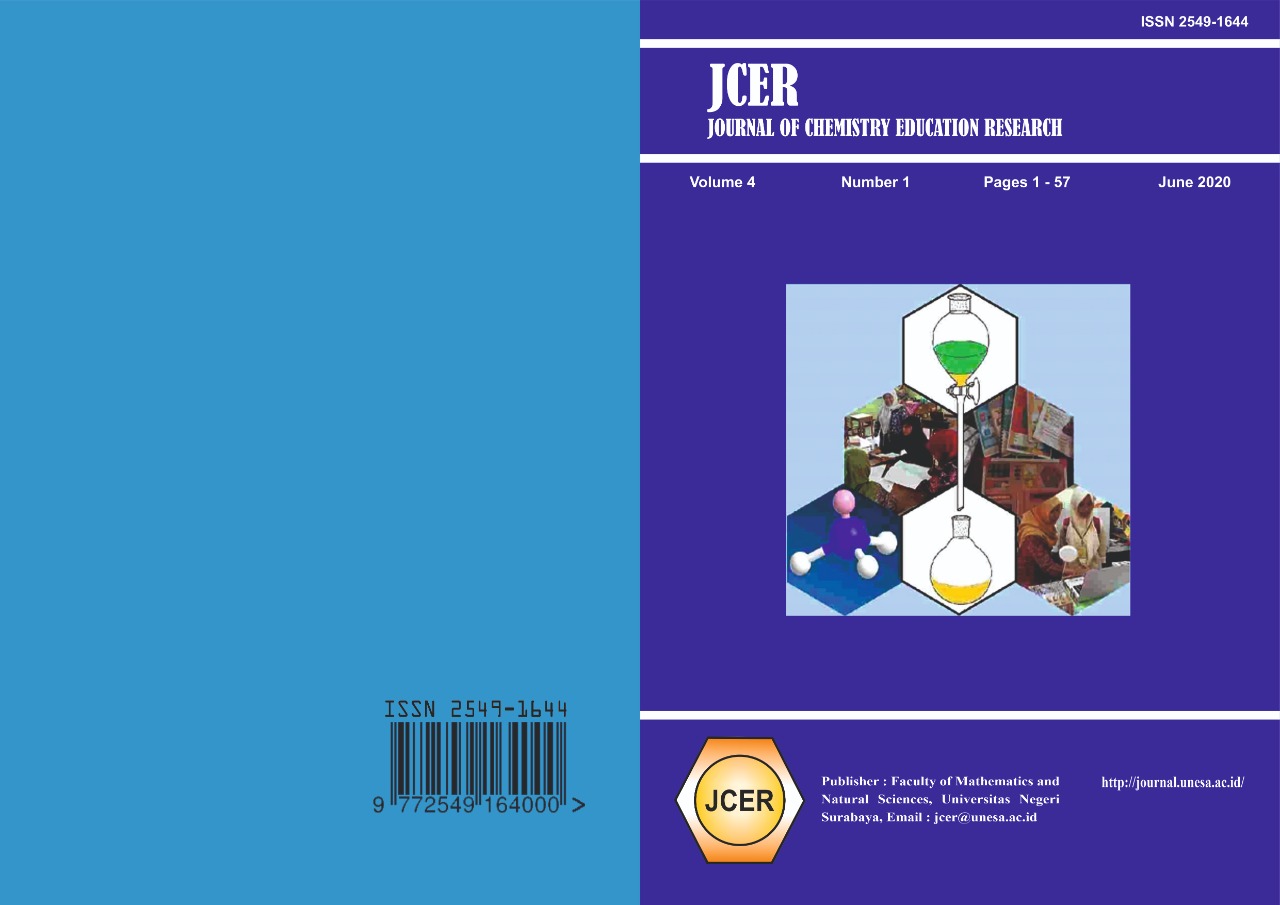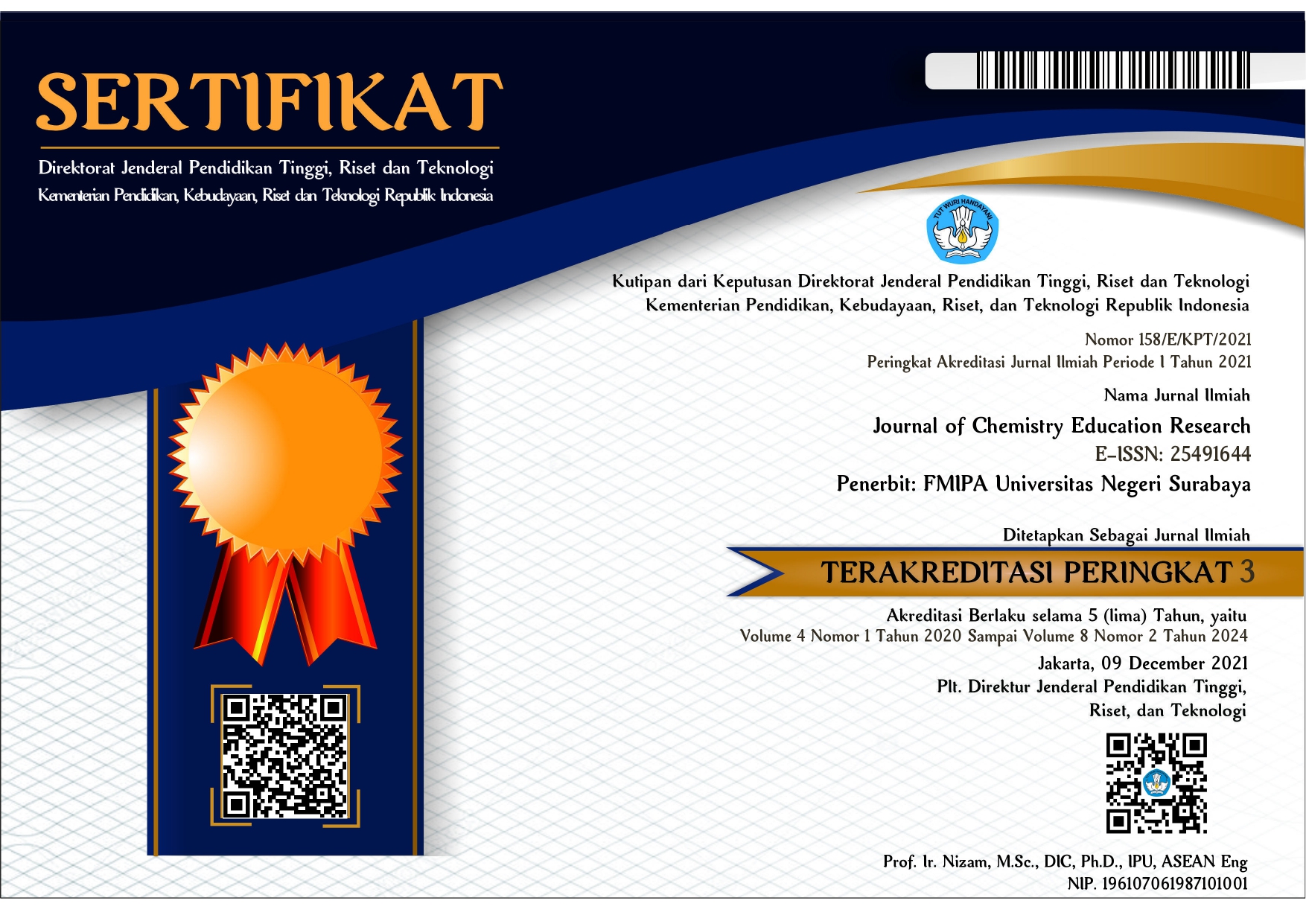LEARNING OF REACTION RATES WITH NESTED CURRICULAR ARRANGEMENT WHICH IS COMBINED WITH CONNECTED CURRICULAR ARRANGEMENT TO IMPROVE CRITICAL THINKING SKILLS OF THE STUDENTS
DOI:
https://doi.org/10.26740/jcer.v4n1.p1-7Abstract
Abstract. This study aims to evaluate a learning of reaction rates with nested curricular arrangement which is combined with connected curricular arrangement to improve critical thinking skills of the students. The evaluation of this study is based on the result of data collecting toward the implementation of learning, students activities, learning outcomes, critical thinking skills, and students responses. This study is conducted using scientific inquiry. The research design used in this study is one group pretest-posttest design including pre-experimental research. The subjects of this study are 36 X graders of MIPA 8 at SMAN 1 Manyar Gresik. The result of this study shows that the implementation of a learning of reaction rates with nested curricular arrangement which is combined with connected curricular arrangement to improve critical thinking skills of the students is in very high value category with percentage of agreement around ≥75% and value of the relevant students activity is greater than the percentage of the irrelevant students activity so that it has a better category. The students learning outcomes and critical thinking skills have significantly improved after conducting a learning about reaction rates with nested curricular arrangement which is combined with connected curricular arrangement which is analyzed using t-test. However, there are some students get post-test score under the expected standard value. This learning about reaction rates with nested curricular arrangement which is combined with connected curricular arrangement receives a positive responses from the students of 87, 22% by collecting data using a questionnaire response.
Keywords: Critical Thinking Skills, Inquiry, Nested, ConnectedReferences
[2]. Paul, Richard and Linda Elder. 2005. The Miniature Guide to Critical Thinking œCONCEPTS & TOOLS. The Foundation of Critical Thinking: California.
[3]. Chostantika, A. L., Haryono & Yamtinah, S. 2013. Penerapan Pembelajaran Model Make a Match dan Diskusi Kelompok untuk Meningkatkan Motivasi Berprestasi, Rasa Ingin Tahu, dan Prestasi Belajar pada Materi Hidrokarbon Siswa kelas X-6 di SMA Negeri 2 Boyolali Tahun Ajaran 2011/2012. Jurnal Pendidikan Kimia, II(3): p. 25.
[4]. Musyaidah, Efendy, dan Aman Santoso. 2016. POGIL, Analogi Model FAR, KBI, dan Laju Reaksi. Malang: Universitas Negeri Malang.
[5]. Cowden, D. C., dan Santiago M. F. 2015. Interdisciplinary Explorations: Promoting Critical Thinking via Problem-Based Learning in an Advanced Biochemistry Class. Journal of Chemical Education. 3(93): 464-469.
[6]. Julianti, H. D. R., Atmojo, T. & Usodo, B. 2014. Eksperimentasi Model Pembelajaran Nested dan Think Pair Share (TPS) dengan Pendekatan Kontekstual pada Materi Pokok Bangun Ruang Sisi Datar Ditinjau dari Kecemasan Belajar Matematika Siswa Kelas VIII MTs Ponorogo Tahun Pelajaran 2013/2014. Jurnal Elektronik Pembelajaran Matematika, II(8):p.867
[7]. Fogarty, Robin. 2009. How to Integrate the Curricula Third Edition. California: Corwin Herron.
[8]. Rahmadhani, Pradita dan Dian Novita. 2018. Penerapan Model Pembelajaran Guided Inqury dengan Pendekatan Nested untuk Meningkatkan Keterampilan Berpikir Kritis Peserta Didik Kelas XI MIA SMA Negeri 1 Manyar pada Materi Laju Reaksi. Skripsi. Surabaya: FMIPA UNESA.
[9]. Muchsen, Hadijah, Andi Tanra T., Lilies N. T. 2016. Penerapan Pembelajaran IPA Terpadu Tipe Connected dalam Meningkatkan Motivasi dan Hasil Belajar Peserta Didik tentang Materi Sistem Peredaran Darah Manusia di Kelas VIII A SMP Negeri 17 Palu. Jurnal Pendidikan. Palu: Universitas Tadulako.
[10]. Arifin, Zainal. 2014. Konsep dan Model Pengembangan Kurikulum. Bandung: PT Rosdakarya Offset.
[11]. Dimyati dan Mudjiono. 1999. Belajar dan Pembelajaran. Jakarta: Rineka Cipta.
[12]. Riduwan. 2015. Skala Pengukuran Variabel-variabel Penelitian. Bandung: Alfabeta.
[13]. Borich, Gary D. 1994. Observation Skill for Effective Teaching. Texas: Macmillan Publishing Company
[14]. Bass, Joel L dan T.L.C. Arthur A. Carin. 2009. Methods for Teaching Science as Inquiry. Boston: Pearson & Allyn and Bacon.
[15]. Djamarah, Syaiful Bahri. 2000. Guru dan Anak Didik dalam Interaksi Edukatif. Jakarta: Rineka Cipta.
Downloads
Published
Issue
Section
License
Authors who publish with this journal agree to the following terms:
- Authors retain copyright and grant the journal right of first publication with the work simultaneously licensed under a Creative Commons Attribution License that allows others to share the work with an acknowledgement of the work's authorship and initial publication in this journal.
- Authors are able to enter into separate, additional contractual arrangements for the non-exclusive distribution of the journal's published version of the work (e.g., post it to an institutional repository or publish it in a book), with an acknowledgement of its initial publication in this journal.
 Abstract views: 300
,
Abstract views: 300
, PDF Downloads: 280
PDF Downloads: 280



